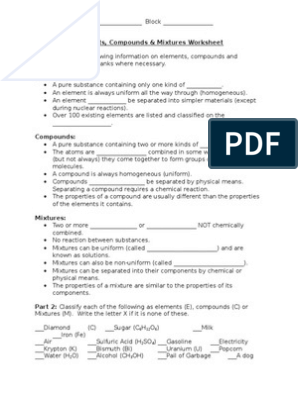ST.
GABRIEL’S SECONDARY SCHOOL
Lower Secondary Science
Chapter 5 Separation Techniques
Worksheet 5.1
Name : ______________________________( ) Class :______ Date :__________
Section A: MCQ
Choose the most suitable answer and write the corresponding letter (A, B, C or D) in the brackets
provided.
1 What is the separation technique used to remove an iron splinter from the eye?
A Filtration B Magnetic attraction
C Simple distillation D Paper chromatography ( )
2 The separation technique used to separate the constituents of a mixture depends on the
__________________________.
A proportion of the constituents in the mixture
B time available for separation
C properties of the constituents of the mixture
D colour of the mixture ( )
Which of the following mixtures can be separated using the separation method shown in the
diagram above?
A Copper filings and nickel filings
B Wood shavings and water
C Oil and water
D Red beans and steel nails ( )
4 What separation technique is used to produce salted fish?
A Simple distillation B Desalination
C Evaporation D Filtration ( )
1
�5 Which of the following sets of apparatus is used to separate a mixture of tea leaves and
tea?
A B
C D
( )
6 Which of the following evaporation techniques is the most rapid?
A B
C D
( )
7 The food colouring contained in a soft drink can be identified using ___________________.
A simple distillation B evaporation
C magnetic attraction D paper chromatography ( )
2
�8
The above apparatus is used to separate the constituents of a mixture. The thermometer
reads 90 °C. Which of the following mixtures can be separated into its constituents using
the apparatus shown above?
A Alcohol and water B Cooking oil and water
C Sugar and water D Salt and sand ( )
9 Which of the following separation techniques is used to obtain sugar from a sugar solution?
A B
C D
( )
10 Crude oil is separated into different fractions by __________________.
A fractional distillation B evaporation
B filtration D paper chromatography ( )
3
�Section B: Short-Answer Questions
11 Name the separation technique that can be used to separate each of the following mixtures
in the table below.
To separate Separation technique
Steel filings from sulfur
Rice from water
Pure alcohol from alcohol and water
Salt from seawater
12
(a) Name the separation technique shown in the diagram above.
(b) What is the substance labelled as X known as?
(c) What is the substance labelled as Y known as?
(d) Describe the type of mixture that can be separated into its components using the
separation technique.
13 (a) Explain how you can separate a mixture of table salt and chalk dust.
4
� (b) Identify a separation technique to obtain pure water from salt solution. Discuss how
pure water is obtained from salt solution using the separation technique you have
identified.
14 A chemist used paper chromatography to investigate some ink in a mixture. The results of
her test are shown in the diagram below.
5
� (a) How many different coloured inks did the mixture contain?
(b) Infer what coloured inks were in the mixture?
(c) State two advantages of using paper chromatography to separate the components of a
mixture.
15 Describe how you can determine the different coloured components in a coloured
mouthwash sample.





































































































